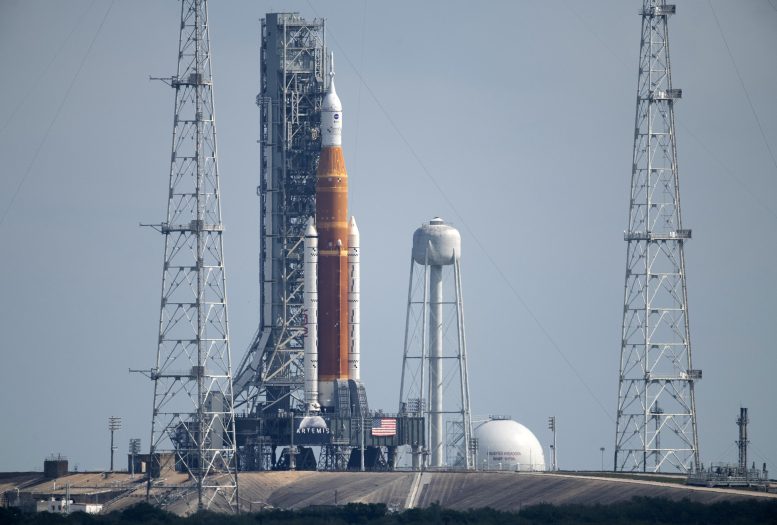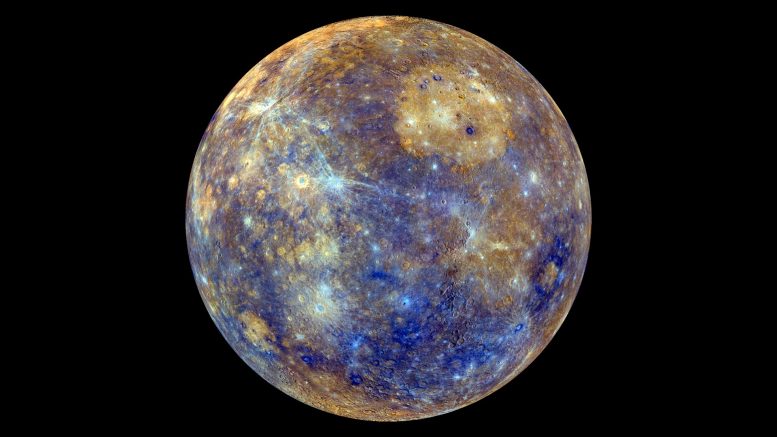.NASA Scrubs Artemis I Wet Dress Rehearsal – Here’s What Happened
http://blog.naver.com/mssoms
http://jl0620.blogspot.com
http://jk0620.tripod.com
https://www.facebook.com/junggoo.lee.9
.NASA Scrubs Artemis I Wet Dress Rehearsal – Here’s What Happened
NASA, Artemis I Wet Dress 리허설을 스크럽 – 여기에서 일어난 일

2022년 4월 3 일 Artemis I SLS 잠수복 리허설 2022년 4월 3일 일요일, 아르테미스 1세 발사팀이 플로리다에 있는 NASA 케네디 우주 센터에서 웨트 드레스 리허설 테스트를 수행하는 동안 오리온 우주선이 탑승한 NASA의 우주 발사 시스템(SLS) 로켓이 발사 단지 39B의 이동식 발사기 꼭대기에서 볼 수 있습니다. . NASA의 Artemis I 비행 테스트에 앞서, 습식 드레스 리허설에서는 Artemis I 발사 팀을 추진제 적재, 전체 발사 카운트다운 수행, 카운트다운 시계 재활용 능력 시연, 일정 및 절차 연습을 위한 탱크 배수 작업을 통해 운영합니다. 시작하다. 크레딧: NASA/Joel Kowsky
-팀은 모바일 런처에 압력을 가하는 능력 상실로 인해 잠수복 리허설을 위해 탱크 작업을 스크럽하기로 결정했습니다. 팬은 모바일 발사기 내의 밀폐된 영역에 양압을 제공하고 위험한 가스를 차단하는 데 필요합니다. 기술자는 이 기능이 없으면 로켓의 핵심 단계와 중간 극저온 추진 단계에 추진제를 안전하게 장전할 수 없습니다. 이제 팀이 만나 다음 단계를 결정하고 향후 계획을 수립합니다. 탱킹을 진행할 다음 기회는 4월 4일 월요일입니다. 팀은 전방 계획의 일부로 범위와 상품 가용성에 대해 논의할 것입니다. 이전 업데이트: NASA Artemis I 웻 드레스 리허설 업데이트: 탱킹 진행 일정: NASA Artemis I 웻 드레스 리허설 준비 진행 중
https://scitechdaily.com/nasa-scrubs-artemis-i-wet-dress-rehearsal-heres-what-happened/
================
메모 2204040501 나의 사고실험 oms 스토리텔링
인류가 드디어 달기지 개발을 본격화 하기 시작했다. 일론 머스크가 화성의 테라포밍을 실현할 우주선 개발을 본격화 함에 따른 달의 우주정류장 내지는 기지화 또는 자원의 확보를 위해 중요한 시도를 기획했다. 아르테미스 계획은 국제간 협력으로 이뤄낼 인류의 과제가 되고 있다. 한국도 물론 이에 참여하고 있다.
달의 표면은 문뜩 샘플a.oms에 크레이터를 연상하게 됐다. 매끄러운 면에서 샘플a.oms는 현실에서 존재하는 것이 아닐듯 하다. 수많은 낙하물로 인하여 파편이 날리면 과연 xy평면에서 oms=1을 발견할 수 있을까 상상을 해본다.
파문과 파편으로 부서진 mser공간에 oms=1은 과연 온존할까? x측에서 바라본 좌우가 동일할까? y축 상하에서 과연 oms=1을 관측할 수 있을까? 이처럼 표면을 두드리는 소행성이나 빛들 x는 언제까지 지속되고 시공간의 변화에서 과연 샘플a.oms는 고정적인 위치에 존재할까? 아닐듯 하다. 그러나 무정의된 기본적인 기준틀은 존재해야 변하는 모습들을 추적할 수 있을 것이다.
단지 그 이유 때문만은 아니지만, 샘플a.oms가 한가지 모형으로 기준이 되지 않을듯하다. 상징적 샘플a.oms는 다차원의 기준점으로도 중요한 단서가 될 수 있다.
Sample a.oms (standard)
b0acfd 0000e0
000ac0 f00bde
0c0fab 000e0d
e00d0c 0b0fa0
f000e0 b0dac0
d0f000 cae0b0
0b000f 0ead0c
0deb00 ac000f
ced0ba 00f000
a0b00e 0dc0f0
0ace00 df000b
0f00d0 e0bc0a
sample b.quasi oms(standard)
0100000010=0,2
0010000100
0001000001
0010001000
0001010000
0000100100
0000100010
2000000000
0000001001
sample b.prime oms(standard)
q0000000000
00q00000000
0000q000000
000000q0000
00000000q00
000000000q
0q000000000
000q0000000
00000q00000
0000000q000
000000000q0
sample c.oss(standard)
zxdxybzyz
zxdzxezxz
xxbyyxzzx
zybzzfxzy
cadccbcdc
cdbdcbdbb
xzezxdyyx
zxezybzyy
bddbcbdca
=bigrip/zerosum, npir+c(dark energy)
sample c.oss
domain(2203080543):

Artemis I SLS wetsuit rehearsal on April 3, 2022 NASA's space launch with the Orion spacecraft aboard while the Artemis I launch team performs wet dress rehearsal tests at NASA's Kennedy Space Center in Florida on Sunday, April 3, 2022 The system (SLS) rocket launch can be seen from the top of the mobile launcher in Complex 39B. . Prior to NASA's Artemis I flight test, a wet dress rehearsal operates the Artemis I launch team by loading propellant, performing a full launch countdown, demonstrating the ability to recycle the countdown clock, and draining tanks to practice schedules and procedures.
===================
memo 2204040501 my thought experiment oms storytelling
Humanity has finally begun to develop the moon base in earnest. As Elon Musk began the development of a spacecraft to realize terraforming of Mars, he planned an important attempt to establish a space station or base on the moon or to secure resources. The Artemis Project is becoming a task for mankind to achieve through international cooperation. Of course, Korea is also participating in this.
The surface of the moon suddenly reminded me of a crater in sample a.oms. In terms of smoothness, the sample a.oms does not seem to exist in reality. Imagine if oms=1 can be found in the xy plane if fragments are blown by numerous falling objects.
Will oms=1 exist in mser space broken by ripples and fragments? Are the left and right sides viewed from the x side the same? Is it possible to observe oms=1 above and below the y-axis? How long does the asteroid or light x hitting the surface last, and does the sample a.oms exist at a fixed position in the change of space and time? it seems not However, an undefined basic frame of reference must exist to be able to track the changing appearances.
It's not just for that reason, but the sample a.oms doesn't seem to be the standard for one model. The symbolic sample a.oms can also be an important clue as a multidimensional reference point.
Sample a.oms (standard)
b0acfd 0000e0
000ac0 f00bde
0c0fab 000e0d
e00d0c 0b0fa0
f000e0 b0dac0
d0f000 cae0b0
0b000f 0ead0c
0deb00 ac000f
ced0ba 00f000
a0b00e 0dc0f0
0ace00 df000b
0f00d0 e0bc0a
sample b.quasi oms(standard)
0100000010=0,2
0010000100
0001000001
0010001000
0001010000
0000100100
0000100010
2000000000
0000001001
sample b.prime oms(standard)
q0000000000
00q00000000
0000q000000
000000q0000
00000000q00
000000000q
0q000000000
000q0000000
00000q00000
0000000q000
000000000q0
sample c.oss(standard)
zxdxybzyz
zxdzxezxz
xxbyyxzzx
zybzzfxzy
cadccbcdc
cdbdcbdbb
xzezxdyyx
zxezybzyy
bddbcbdca
=bigrip/zerosum, npir+c(dark energy)
sample c.oss
domain(2203080543):

.What Mercury’s Unusual Orbit Reveals About the Sun [Video]
수성의 비정상적인 궤도가 태양에 대해 밝혀주는 것 [비디오]

2022년 4월 3 일 무지개 빛깔의 수은 인간의 눈에는 수성이 둔한 회색 구체와 비슷할 수 있지만 NASA의 메신저 탐사선에서 촬영한 이 향상된 색상 이미지는 완전히 다른 이야기를 알려줍니다. 무지개 빛깔의 파란색, 모래 색의 평원, 회백색의 섬세한 가닥이 우리 태양계의 가장 안쪽 행성에 대한 미묘하고 다채로운 전망을 만듭니다. 크레딧: NASA / JHU 응용 물리학 연구소 / Carnegie Inst. 워싱턴
-수성은 특별합니다. 태양과 가장 가까운 행성으로 태양의 영향이 극적으로 변화하는 지역을 차지하고 있다. 태양에 가까운 공간을 지배하는 태양의 자기장이 빠르게 약해지고 있습니다. 그리고 수성의 궤도(다른 어떤 행성보다 더 타원형 또는 "타원형")는 다른 어떤 행성보다 더 넓은 범위의 태양 자기장 조건을 경험할 수 있도록 합니다. 결과적으로 수성은 행성에 대한 태양의 영향이 거리에 따라 어떻게 변하는지 연구할 수 있는 독특한 기회를 제공합니다.
-Nature Communications 에 발표된 새로운 연구에서 Goddard 과학자 Norberto Romanelli와 Gina DiBraccio는 NASA 의 MESSENGER 우주선 데이터를 사용하여 수성과 태양의 변화하는 상호 작용을 연구했습니다. 수성이 태양풍을 통과하여 이동하면서 입자의 꾸준한 흐름이 태양을 벗어나면서 일부 입자가 수성의 자기권에 부딪혀 태양을 향해 되돌아옵니다. 이 반동하는 태양풍 입자는 공간을 통해 반향을 일으키는 저주파를 생성하여 태양을 향한 태양풍의 "상류"로 이동합니다. Romanelli와 DiBraccio는 수성에서 발산하는 이 파동을 관찰하고 파동 생성 속도가 수성의 궤도 전체에 걸쳐 다양하다는 것을 발견했습니다. 수성이 태양에서 멀어질수록 더 많은 파동이 발생했습니다. 가까울수록 파동 생성률이 떨어졌습니다. 결과는 이러한 파동이 부분적으로는 거리에 따라 약해지는 태양 자기장의 강도에 의해 영향을 받는다는 이론에 대한 핵심 증거를 제공합니다.
https://youtu.be/n2qv6Mi7Vx0
동영상 대본: 따라서 수성은 태양에 가장 가까운 행성이기 때문에 특별할 뿐만 아니라 태양으로부터의 거리가 태양계의 다른 어떤 행성보다 다양하기 때문에 특별합니다. 수성은 실제로 나머지에 비해 매우 타원형의 궤도를 가지고 있습니다. 수성은 실험을 실행하기 위한 천연 실험실입니다. 우리는 행성이 태양에서 점점 멀어질수록 주위를 관찰하고 변화하는 것을 볼 수 있습니다. 태양풍 입자가 이 자기권 경계에서 반사될 때 저주파를 생성합니다. 그들은 태양풍으로 상류로 이동하는 잔물결과 같습니다. 태양에서 멀어질수록 태양의 자기장은 약해집니다. 우리는 이것이 더 많은 파도가 생성되도록 하는 핵심 매개변수라는 것을 발견했습니다. 이것은 수성이 태양에 얼마나 가깝고 궤도의 모양 덕분에 수성으로만 측정할 수 있는 것입니다. 참조: N. Romanelli 및 GA DiBraccio, 2021년 11월 19일 Nature Communications 의 "수성의 전진에서 초저주파의 발생률은 태양 중심 거리에 따라 증가 합니다. " DOI: 10.1038/s41467-021-26344-2
https://scitechdaily.com/what-mercurys-unusual-orbit-reveals-about-the-sun-video/
================
메모 2204040544 나의 사고실험 oms 스토리텔링
태양으로 부터 가장 가까운 행성인 수성은 작고 단순해 보이지만 '특별한 것들이 많다'는 것을 수성을 직접 연구한 이들이 말한다. 그 무엇보다 수성의 궤도(다른 어떤 행성보다 더 타원형 또는 "타원형")는 다른 어떤 행성보다 더 넓은 범위의 태양 자기장 조건을 경험할 수 있도록 한다.
나는 샘플a.oms에서 vixer를 태양 모드로 생각하고 smola들을 행성들로 가정해 본다. 세로의 중앙을 기준으로 회전할 수 있는 모드이다. 각기 하나의 가로에는 abcdef가 있지만 각기 다른 위치에서 xpi회전운동을 하고 있다. 왜 이런 일이 벌어질까?
전체적으로 'oms조건에 만족해야 하는' 자연원리가 존재함이 아닐까? 그것은 우주의 일반 항성이 행성의 공전과 자전 궤도에 반응하여 자기장의 조건들이 나타난 변화의 원인일 수도 있다.
수성이 특별한 이유도 Sample a.oms를 항성에 최근거리 행성을 하나의 시스템 모형으로 받아드려 본 바, 그 다채로운 변화들이 잘 이해될 수 있다. 허허.
Sample a.oms (standard)
b0acfd 0000e0
000ac0 f00bde
0c0fab 000e0d
e00d0c 0b0fa0
f000e0 b0dac0
d0f000 cae0b0
0b000f 0ead0c
0deb00 ac000f
ced0ba 00f000
a0b00e 0dc0f0
0ace00 df000b
0f00d0 e0bc0a
sample b.quasi oms(standard)
0100000010=0,2
0010000100
0001000001
0010001000
0001010000
0000100100
0000100010
2000000000
0000001001
sample b.prime oms(standard)
q0000000000
00q00000000
0000q000000
000000q0000
00000000q00
000000000q
0q000000000
000q0000000
00000q00000
0000000q000
000000000q0
sample c.oss(standard)
zxdxybzyz
zxdzxezxz
xxbyyxzzx
zybzzfxzy
cadccbcdc
cdbdcbdbb
xzezxdyyx
zxezybzyy
bddbcbdca
=bigrip/zerosum, npir+c(dark energy)
sample c.oss
domain(2203080543):

- Mercury is special. As the planet closest to the sun, it occupies an area where the sun's influence changes dramatically. The Sun's magnetic field, which dominates space close to the Sun, is rapidly weakening. And Mercury's orbit (more elliptical or "elliptical" than any other planet) allows it to experience a wider range of solar magnetic field conditions than any other planet. As a result, Mercury offers a unique opportunity to study how the Sun's influence on the planet changes with distance.
-In a new study published in Nature Communications, Goddard scientists Norberto Romanelli and Gina DiBraccio used data from NASA's MESSENGER spacecraft to study the changing interactions between Mercury and the Sun. As Mercury moves through the solar wind, a steady stream of particles leaves the Sun, causing some to hit Mercury's magnetosphere and return toward the Sun. These recoiling solar wind particles travel "upstream" of the solar wind towards the sun, generating low frequencies that reverberate through space. Romanelli and DiBraccio observed these waves emanating from Mercury and found that the rate of wave generation varies throughout Mercury's orbit. As Mercury moved away from the sun, more waves occurred. The closer you got, the lower the wave generation rate. The results provide key evidence for the theory that these waves are influenced in part by the strength of the solar magnetic field, which weakens with distance.
===================
memo 2204040544 my thought experiment oms storytelling
Mercury, the closest planet to the Sun, looks small and simple, but those who have studied Mercury say that it has 'a lot of special things'. Above all else, Mercury's orbit (more elliptical or "elliptical" than any other planet) allows it to experience a wider range of solar magnetic field conditions than any other planet.
I think of vixer as solar mode and smolas as planets in sample a.oms. It is a mode that can be rotated based on the vertical center. There is an abcdef in each horizontal direction, but it is performing xpi rotation at different positions. Why would this happen?
Isn't there a natural principle that 'must satisfy the oms condition' as a whole? It may be the cause of the changes in magnetic field conditions in response to the orbits of planets orbits of ordinary stars in the universe.
The reason Mercury is special is that Sample a.oms has been accepted as a system model for planets that are closest to the star, so the colorful changes can be well understood. haha.
Sample a.oms (standard)
b0acfd 0000e0
000ac0 f00bde
0c0fab 000e0d
e00d0c 0b0fa0
f000e0 b0dac0
d0f000 cae0b0
0b000f 0ead0c
0deb00 ac000f
ced0ba 00f000
a0b00e 0dc0f0
0ace00 df000b
0f00d0 e0bc0a
sample b.quasi oms(standard)
0100000010=0,2
0010000100
0001000001
0010001000
0001010000
0000100100
0000100010
2000000000
0000001001
sample b.prime oms(standard)
q0000000000
00q00000000
0000q000000
000000q0000
00000000q00
000000000q
0q000000000
000q0000000
00000q00000
0000000q000
000000000q0
sample c.oss(standard)
zxdxybzyz
zxdzxezxz
xxbyyxzzx
zybzzfxzy
cadccbcdc
cdbdcbdbb
xzezxdyyx
zxezybzyy
bddbcbdca
=bigrip/zerosum, npir+c(dark energy)
sample c.oss
domain(2203080543):
댓글